Thursday , September 17, 2009
By George Russell

http://www.foxnews.com/story/0,2933,551480,00.html
As the United Nations General Assembly reconvenes in New York City this week, Secretary General Ban Ki-moon intends to present its members with a two-year headquarters budget that he claims will be as stingy as these recessionary times demand. It will total just $4.9 billion, a trifling 0.5 percent — or $22.4 million — more than the U.N. spent over the previously two years. The U.S. pays 22 percent of the new budget total, or about $1.08 billion.
“This level of resources,” Ban proclaims in his introduction to the 1,702-page budget document, “is the outcome of the lengthy budget formulation process, reflecting a thorough review and extensive consultations with program managers to ensure the optimal utilization of resources in order to fully, efficiently and effectively implement the objectives and mandates set by Member States.”
Ban’s claim, however, is deeply misleading. In fact, the same budget document shows that Ban is on track to maintain and surpass his previous record as the biggest spender in U.N. history.
And whatever the totals turn out to be, the cost of paying them will weigh most heavily on the United States, which in addition to paying nearly a quarter of the regular U.N. budget, pays up to 26 percent of its peacekeeping costs, and large amounts of the money for a bewildering variety of U.N. cost centers that make up the sprawling U.N. Secretariat budget. In 2007, the top 17 dues-paying countries in the U.N. paid 86.5 percent of the entire U.N. regular budget, while the 128 lowest-paying members paid only 1 percent.
Overall, Ban’s new budget document shows, the U.N. Secretariat is actually planning on an eye-popping $13.9 billion in “regular” and “extra-budgetary” spending in its 2010 and 2011 budget. That is hike of some $968 million over the spending during the previous two-year period, or a 7.5 percent increase.
The increase, however, is likely to grow much bigger as it is adjusted upward during the two year period, as it inevitably is. And the share that the U.S. will pay of that total is very difficult to determine.
The same figures show that the U.N. Secretariat will employ 22,421 people in 2010-2011 — more than double the number Ban lists on his “regular” budget.
Click here to see the overall cost and personnel totals.
The enormous gap between the $4.9 billion “regular” total and the $13.9 billion overall figure is a reflection of the Byzantine, esoteric and — for anyone trying to control U.N. costs — frustrating U.N. budget process, in which the world organization fudges figures, delays revelations about add-on costs, and counts only about a third of the money it spends every biennium as its “regular budget,” even while the bigger total is the real basis for its activities.
Click here for an overview of the 2010-2011 budget.
And the spending totals the Secretary General presents at the beginning of each budget cycle tend to go dramatically up as the cycle progresses. At the same point in the previous two-year U.N. budget cycle, for example, Ban Ki-moon estimated that the combination of “regular” and “extra-budgetary” spending for 2008-2009 would be $10.47 billion. Instead, the U.N. spent $12.97 billion — $2.5 billion, or nearly 24 percent, more than it originally declared.
“It’s easier to work your way through the U.S. budget — which is immensely bigger — than through the U.N. budget,” observes Brent Shaefer, a U.N. expert at the conservative Heritage Foundation, who has just edited a new book on U.N. reform entitled ConUNdrum: The Limits of the United Nations and the Search for Alternatives. “What you see is the U.N. doing a bit of sleight of hand.”
Nor does the sleight of hand end there. Even the $13.9 billion number does not include the cost of some of the U.N.’s biggest and most sprawling organizations, which submit their own budgets to separate panels of U.N. member states, even as their programs increasingly intertwine and overlap.
These include behemoths like the United Nations Development Program (UNDP), which spends in excess of $6 billion annually — the organization has suspended consideration of its next biennial budget until early next year— or the World Food Program (WFP), which wants to spend $6.3 billion in 2010-2011, as well as the World Health Organization (WHO), which spent $4.2 billion in 2008-2009.
Yet even with those exceptions, as a result of the legerdemain of the U.N. budgeting process, the $13.9 billion spending figure in Ban’s proposed budget is a very understated presentation of U.N. spending plans — by significantly more than 100 percent.
To take just a small matter first, the inflation-adjusted total for the $4.9 billion regular budget brings it immediately to $5.06 billion — and that is only a “preliminary” adjustment.
Nor does it include the full impact of what the U.N. calls “special political missions,” which nowadays include the rapidly spiralling U.N. civilian and development deployments in Iran and Afghanistan. Ban’s introduction to the latest budget declares that these special missions are expected to cost $776.3 million. But later on, the document says the total so far is actually $867.4 million.
In fact, the number is still a moving target, that will change throughout the two year period—never in a downward direction. At the same stage in the U.N.’s budget process two years earlier, the cost of special political missions was estimated at $623.5 million. In the end, the U.N. spent $867 million, an increase of 39 percent.
The U.N.’s budgetary committee has asked Ban to prepare an “updated” estimate for the special missions the General Assembly begins its deliberations.
Nor does the budget include all the likely costs of a major overhaul of U.N. business and information technology, dubbed the Umoja project, which is tallied in Ban’s budget as costing anywhere from about $78.5 million to $186 million in 2011-2011. A recent draft report on the project obtained by FOX News, however, proposes a cost of $232.5 million for the same period — with much more to come later.
More importantly, even Ban’s biggest numbers fail to include the rapidly spirally annual cost of U.N. peacekeeping operations — which will amount to about $7.8 billion just for the period from July 2009 to June 2010.
Click here to see the approved peacekeeping estimate.
The U.S. share of the 2009-2010 peacekeeping package is just under 26 percent of the total, or $2.01 billion — up about $120 million from the previous year. The share can grow to 27 percent before it hits a ceiling mandated by the U.S. Congress.
The $7.9 billion for peacekeeping is treated as a separate element in U.N. accounting, and approved separately by the General Assembly.
Only $586 million worth of peacekeeping operations expenses — which are over and above the $7.8 billion — are listed in Ban’s 2010-2011 headquarters budget.
There is not a great deal of likelihood that overall peacekeeping expenses — which have rocketed from a planned $5.3 billion in the 12 months ending in July 2008 to the current total, a 47 percent hike — will shrink in the years ahead.
Even assuming no change in the rate of spending, that means that in the period covered by Ban’s biennial budget, which includes 18 additional months of peacekeeping, U.N. peacekeeping outlays might run to $15 billion all by themselves — and the U.S. share could reach $3.9 billion, or even more.
So, why are the U.N. budget figures heralded by Ban at the beginning of his proposed budgets so low?
The chief reason is a definition of the “core” or “regular” U.N. budget that refers only to spending covered by mandatory payments — in effect, U.N. dues — by the U.N. member states. The “core” budget is the smaller number, and, as Ban’s introduction to this year’s budget shows, much more apparent effort goes into keeping costs down in the “core.”
But even when announcing increases in those “core” budget numbers for the new budget, Ban fudges.
To arrive at his tiny $22 million spending increase, Ban, as is customary at the U.N., compares the final version of the previous “core” biennial budget — what the U.N. actually spent, with only the first version of the next biennial plan — the most expensive version of the past, in effect, with the lowest initial estimate of the future.
For example, when Ban first introduced the budget for 2008-2009, the Secretariat used an initial figure of $4.19 billion — about $620 million less than the U.N. actually spent in that period. In other words, in the last biennium, the U.N. “core” budget actually increased by 15 percent more than what Ban initially said it would be.
As it happens, when he first presented that initial 2008-2009 budget, Ban declared that the initial estimated regular budget number was also just 0.5 percent higher than the previous two-year budget number — using exactly the same apples-to-oranges comparison that he uses this time.
Rather than the 0.5 percent increase that he heralds, Ban’s latest initial estimated “regular” or “core” budget for 2010-2011 starts out $700 million higher than his initial estimate for the 2008-2009 biennium — an increase of 17 percent before taking account of any subsequent inflation adjustment and further cost growth.
The Heritage Foundation’s Schaefer, in fact, estimates that the U.N. regular budget has been growing at an average rate of 17 percent annually since about 2002 During that same period, Schaefer says, the U.S. budget grew by an average of only 7 percent annually.
Ban’s figure-juggling, however, is not over. He adds estimates for cost inflation, currency exchange rates and other factors that bring his low-ball initial estimate for 2010-2011 from $4.9 billion to about $5.03 billion — roughly $634 million, or 14 percent, more than his low-ball cost adjusted estimate for 2008-2009.
The biggest, and most time-honored U.N. device that Ban uses is a distinction between the organization’s “core” and “non-core” budgets. The “non-core” or “extra-budgetary” spending is supplementary spending that is provided voluntarily by contributing states rather than through a dues formula. It amounts to twice as much as the U.N. spends on “core” items.
Yet even though this “extra-budgetary” spending is voluntary, it is remarkably solid — it amounted to $8.7 billion in 2008-2009, according to Ban’s latest spending document — and comes principally from the same countries as the regular budget does.
In 2010-2011, Ban initially foresees this “extrabudgetary” spending on a rise again, to $9.44 billion, up from $8.66 billion spent in the previous two years. Ban’s office calls the 9 percent projected hike “modest,” and “using conservative estimates based on past experience” and donor undertakings. When queried by FOX News as to whether the Secretary General foresaw further growth in that number in the years ahead, Ban’s office replied that instead, they saw the amount of the increase being ratcheted downward — to $9.3 billion.
But once again, Ban’s budget for 2010-2011 is comparing the final number spent in the previous two years with the initial estimate for “extra-budgetary” spending in 2010-2011. The initial extra-budgetary number for 2008-2009 was just $6.59 billion — meaning that his new initial estimate is a huge $2.85 billion, or 43 percent, higher than its true equivalent in the previous biennium.
Among other things, a substantial portion of the extra-budgetary increase, Ban’s report notes, has gone to the Office of the United Nations High Commissioner for Refugees — $282.2 million — and the United Nations Relief and Works Agency for Palestinian Refugees in the Near East (UNWRA) — $186.9 million.
(As it happens, Ban’s initial budget report for 2008-2009 said very similar things, noting that big increases from hikes in extra-budgetary resources went to UNHCR — $423.3 million — and UNWRA — 122.9 million.)
Click here to see a breakdown of U.N. planned spending by regular and extra-budgetary categories.
Ban’s office says it has “no reason to believe that Member States would not honor their commitments” for extra-budgetary funds.
Perhaps the biggest sign of how confident the U.N. is of at least the bulk of this “extra-budgetary” spending is the number of people it employs with it: 12,153 in 2008-2009, vs. about 10,180 by means of the “regular” budget. In 2010-2011, Ban expects to keep 12,271 people employed using “extra-budgetary” resources — a remarkably stable number.
In other words, about 54 percent of Ban’s Secretariat staff is currently not on the “regular” budget books, and he expects the proportion to stay that way.
In his latest budget presentation, Ban makes much of the fact that he has cut 32 jobs, or about 0.3 percent of the “core” U.N. staff, in his initial estimate.
But on the “extra-budgetary” side, Ban has actually added an additional 118 positions. Net gain: 86. Overall, about an 0.4 percent hike.
Rather than unprecedented fiscal discipline, what Ban’s numbers actually show is that hikes in both the U.N.’s “regular” and “extra-budgetary” spending over the past four years represent a dramatic break with past efforts of major donor countries, led by the U.S., to enforce tougher fiscal discipline.
The watershed in that effort came during the last biennium — the first where Ban Ki-Moon was completely responsible for the budget process.
Led by a shock-wave of developing countries, the U.N. General Assembly abandoned a 20-year tradition of adopting its budgets only by consensus — a custom that gave major donor countries like the U.S., which enjoy only one vote, unofficial clout on budgetary matters in keeping with their financial contributions
In 2008, however, the General Assembly took an official vote on the 2008-2009 budget — and approved it, 142-1. The only No vote came from the U.S., in one of the last acts of the outgoing Bush Administration.
That result, according to Heritage’s Schaefer, meant that “the majority of UN member states who contribute very little to the budget no longer feel the need to listen to the concerns of its largest contributor.”
For its part, Ban’s office, in reply to questions from FOX News, declared that “the Secretary General continues to exercise maximum budgetary discipline and has presented a budget proposal in line with the budget outline as approved by the General Assembly. He will be presenting a number of proposals which are either new or respond to earlier mandates of the General Assembly.
“The ultimate level of the budget,” Ban’s spokesman added, “is a decision solely within the purview of Member States.”
Will the Obama Administration, which differs greatly from its predecessor in its avowed intention to rely further on the U.N. for diplomatic purposes, find the continuing U.N. spendfest a problem?
It remains to be seen — most likely in the labyrinthine results of the U.N. budget process.
George Russell is executive editor of FOX News.



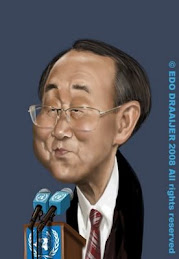












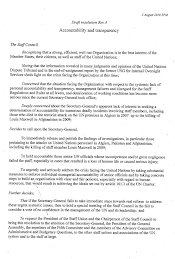

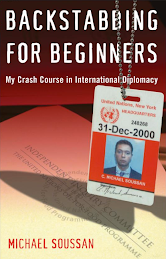
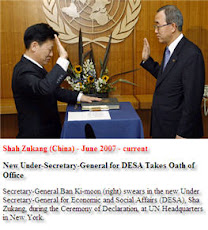

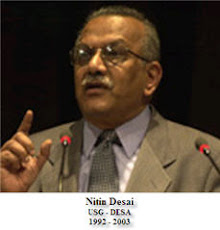
No comments:
Post a Comment